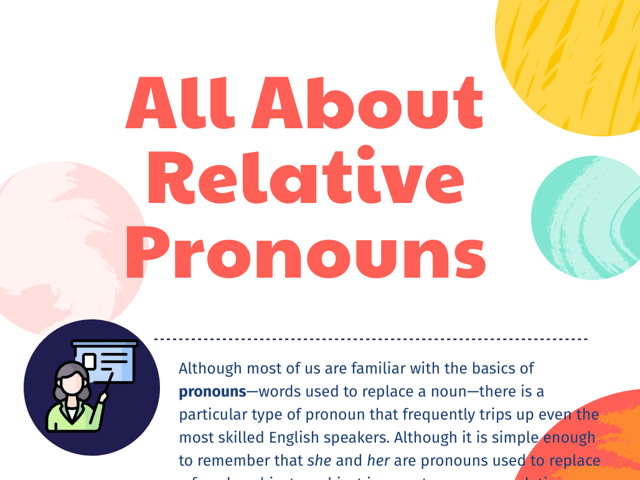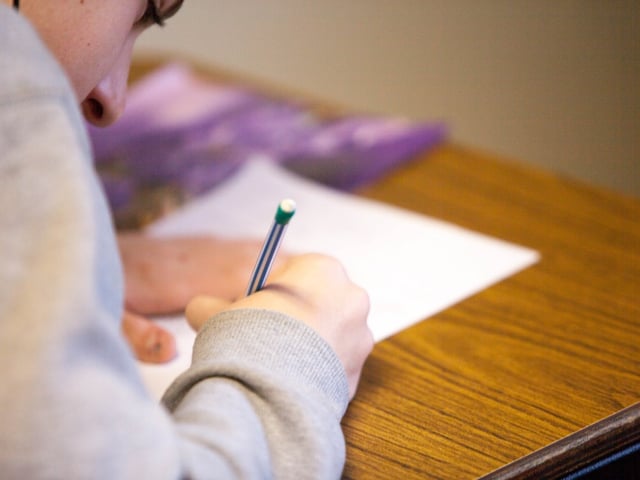
All About Relative Pronouns
Although most of us are familiar with the basics of pronouns—words used to replace a noun—there is a particular type of pronoun that frequently trips up even the most skilled English speakers. Although it is simple enough to remember that she and her are pronouns used to replace a female subject or object in a sentence, many relative pronouns are not quite as simple to quantify. To start, let’s identify the meaning of relative pronoun and the words that fall under this banner.
The Role of a Relative Pronoun
The term relative pronoun is so named for its status as an introductory element for relative clauses. A relative clause is a dependent clause that is introduced or accompanied by a relative pronoun. Relative clauses cannot stand on their own, and require additional clauses or sentences in order to form a complete and comprehensive thought. The words that qualify as relative pronouns include the following: who, whom, whose, which, and that. Which and that are used to replace things or objects, while who, whom, and whose are used to replace people or animate objects.
Using Relative Pronouns Correctly
Relative pronouns can be difficult to determine and use because they require an understanding of pronoun-antecedent agreement, basic rules of grammar, and the requirements put in place to form complete sentences. The best way to familiarize yourself with the rules involved in using relative pronouns correctly is to practice again and again, using varying sentence structures and ideas.
Pronouns for Living Things
To start, we will begin using the three relative pronouns used to replace animate objects or people.
-
“Rose and Risa, whom we love, are coming to visit this summer.”
-
“The PTA dad, who was always present at parent-teacher meetings, was a fan favorite at school gatherings.”
-
“The gaggle of parents, whose brownies stole the hearts of countless faculty members last semester, arrived at the game to sell their home-baked goods.”
Each of the sentences above relies on the relative clause and relative pronoun to construct a full sentence. Without whom, for instance, the first sentence would read,
“Rose and Risa, we love, are coming to visit this summer.”
This would render the clause awkward and ill-fitting.
Note: It can be difficult to know when to use who and when to use whom. The best way to remember which to use is to abide by this rule: “who” is used to replace the subject of a sentence (“He who smelt it dealt it.”), while “whom” is used to replace the object of the sentence’s verb or preposition (“The teacher, for whom the party was being thrown, was three hours late.”).
Pronouns for Objects
Now, consider these two sentences:
-
“The houses, which we once loved, became little more than specters to our eyes.”
-
“The crying animal that Jack gathered into his arms began to settle and relax.”
The words which and that are the relative pronouns found in the sentences above.
Without these pronouns, the relative clauses would sit strangely in the sentence and would not make sense. Although sentences can be structured without relative clauses and their corresponding relative pronouns, these sentence elements increase the nuances and structure of sentences, and can create a far more dynamic sentence structure.
Note: It can be similarly difficult to know the difference between using “which” and “that”. To determine which word to use, you must first determine the nature of the sentence itself. Because both words are used to introduce a clause, you must evaluate the portion of the sentence separate from the clause. If the sentence is coherent without the clause, you use which, but if the sentence’s meaning is convoluted, that is the correct word to use. Note the following examples:
-
The two cars, which should not have been driven in their current state, puttered haphazardly down the road.
-
The two cars that should not have been driven in their current state puttered haphazardly down the road.
The first sentence is focusing on the puttering of the cars, while the second sentence focuses on the state of the cars. Using which and that in the same position alters the meaning of the sentence. You can also usually tell if that or which should be used by looking at the presence (or lack) of commas, or if you can see there is a natural pause in the sentence.
Although relative pronouns can be difficult to use, remember: a pronoun is used to replace a noun. Relative pronouns, for all of their pomp, are simply words used to replace a pronoun and introduce the presence of a dependent, relative clause.

Keep Reading

ACT Blog
Essay Writing Practice and Prompts for the ACT
The ACT writing test is an optional exam, and is not always given as pa…

ACT Blog
How to Do Well on the ACT Essay
Understanding the ACT Essay Before diving into strategies to excel, it…

ACT Blog
How to Study for the ACT in One Week
Getting ready for American College Testing (the ACT) can be a source of…